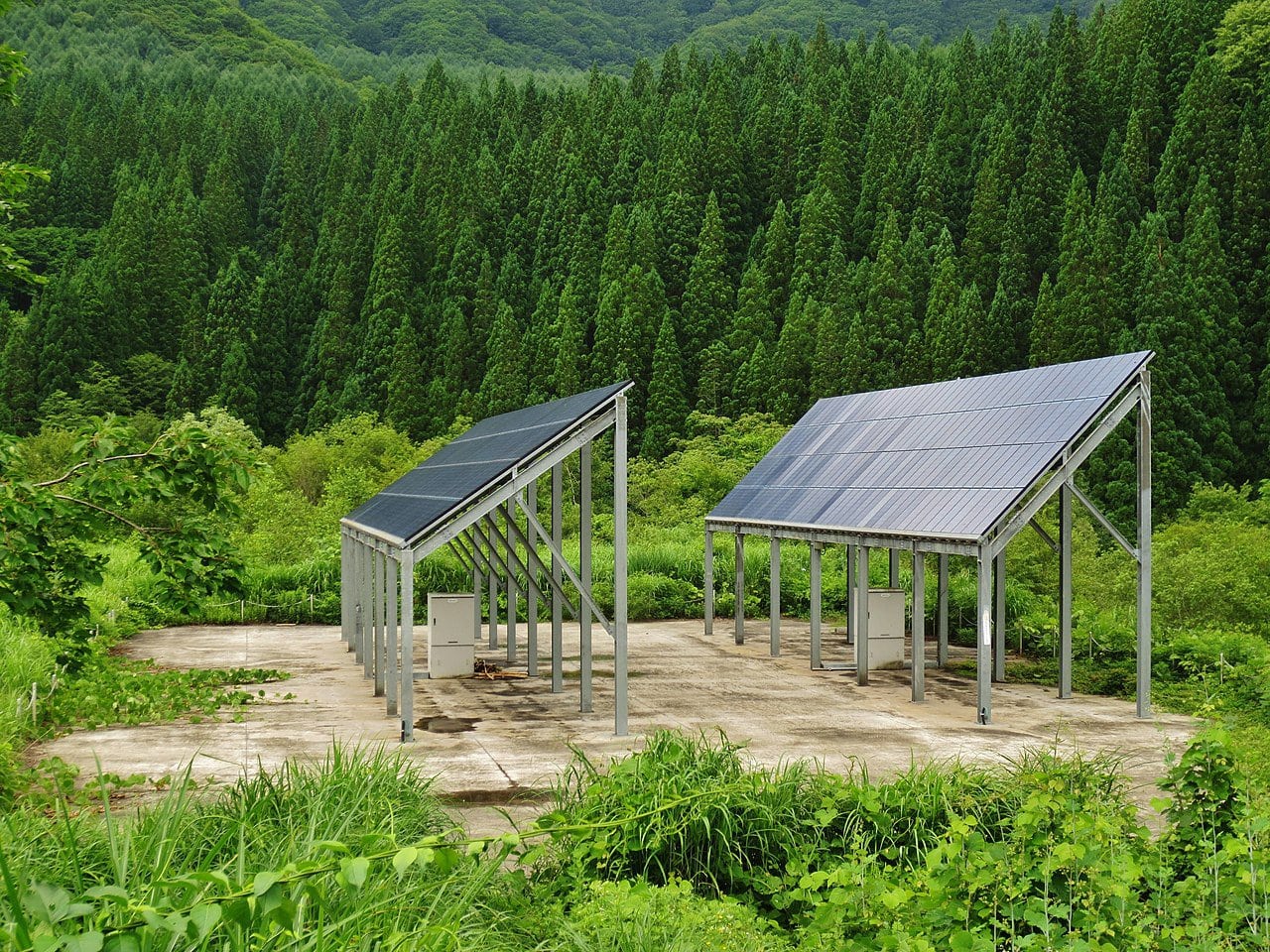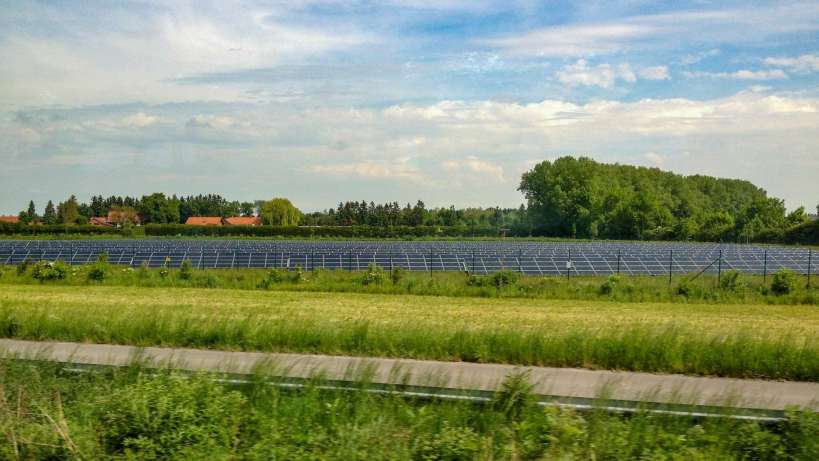Solar farms are a great source of energy when we want to have a switch to a greener future. The thing is, to do their jobs, these farms need large space, which can be problematic as space is getting scarcer along with the growth of humanity.
That may not happen, as new Cornell research found that growing commercial crops on solar farms is not only possible, but also better, potentially. Furthermore, a researcher at the University of New England found that these solar farms can benefit wildlife.
Lead author of the Cornell research Henry Williams said, “We now have, for the first time, a physics-based tool to estimate the costs and benefits of co-locating solar panels and commercial agriculture from the perspective of increased power conversion efficiency and solar-panel longevity.”
Senior author Max Zhang further explained that there are probable systems called agrivoltaics where agriculture and solar panels coexist.
The systems could help increase passive cooling through taller panel heights, give more reflective ground cover as well as higher evapotranspiration rates compared to traditional solar farms. “We can generate renewable electricity and conserve farmland through agrivoltaic systems,” Zhang said.
For those who don’t know, evapotranspiration is the process where water vapor rises from the plants and soil.
According to a previous study from Zhang’s group, New York, for instance, has developed 40% of utility-scale solar farm capacity on agricultural lands. Meanwhile, there’s around 84% of agricultural land deemed suitable for utility-scale solar development.
Using a model, the research group assessed solar panel height, light reflectivity of the ground, and rates of evapotranspiration. They found that agrivoltaic systems have the feasibility to solve global food and energy problems in the future.

Cooling effect on solar panels and crops
In the Cornell research, the team discovered that when solar panels are placed over vegetation, it would result in surface temperature drops when compared to those built over bare ground.
This case, the vegetation was a soybean crop. Solar panels were mounted 4 meters above it, and the solar modules showed temperature reductions by up to 10 degrees Celsius.
The cooling effect due to increased evapotranspiration from vegetation and soil is more significant and preferable than that caused by taller panel height. Moreover, passive cooling makes solar panels more efficient when compared with exposed soil or gravel.
And, when the temperature isn’t as high, it leads to more solar panel lifespan; which, in turn, improves economic potential in the long run.
“As you decrease the solar panel operating temperature, you can increase efficiency and improve the longevity of your solar modules. We’re showing dual benefits. On one hand, you have food production for farmers, and on the other hand, we’ve shown improved longevity and improved conversion efficiency for solar developers,” Williams said.
According to the World Resources Institute, there may be an increase of 50% in global food demands by 2050 to feed an expected 10 billion people. Therefore, it’s important to understand potential solutions to increase agricultural production and renewable energy at the same time.
Zhang said that areas with hot climates like the western United States would be best for agrivoltaic farms, saying that the benefits of these systems have been most prominent around hot and arid climate zones.
In the end, this study concluded, “This paper is taking a step toward evaluating the viability of agrivoltaics in climates representative of the Northeastern U.S. in relaxing the land-use competition the world faces.”
Solar farms that provide a sanctuary for wildlife
As I’ve briefly mentioned, another study also explored the possibility of combining solar farms with wildlife—in this case, Australian wildlife.
Australia has transitioned into renewable energy, deploying large solar farms on its lands. While it’s great, what we should remember is that the country’s wildlife has decreased due to many factors, one of which is invasive species. Additionally, the government has built the farms mostly in rural areas, ones with more contact with wildlife habitat.
Of course, the farms have raised concerns. However, since there’s the possibility of agrivoltaics, there’s also one for conservoltaics—solar farm systems that let wildlife conservation, solar energy, and humanity win.
Eric Nordberg, a senior lecturer at the University of New England, Australia, examined whether solar farms could also help conserve and provide habitat for Australian wildlife while also put the land and farmers at an advantage.
According to Nordberg, Australia’s national parks and protected areas only cover 9% of the continent. Trees have been cut to provide agricultural land as well as pasture for livestock, leaving wildlife only a fraction of its habitat.
So, the senior lecturer did some surveys and trapping to identify the kinds of plants and animals which have occupied solar farms, how long they take to populate the areas, and how humanity can promote more biodiversity despite using solar farm infrastructures.
“My new paper coins a new term for this dual land-use: conservoltaics. I highlight research from overseas into how solar parks can bring conservation benefits, and describe the research still needed,” Nordberg stated.
Nordberg also explained that solar panels and vegetation under or between the panel rows can provide shelters for animals when they need perch or nesting structures, or when they’re faced with elements and predators, much like artificial reefs in lakes and oceans.

Management strategies needed to ensure success
Aside from the Cornell study, there has been previous research which has shown that large solar farms can potentially enhance diversity and abundance of plants and pollinators. Moreover, shade patches created by the panels could also provide micro-habitats for all animals and plants.
To guarantee positive results for wildlife, the environment, and people, there should be good management strategies. Nordberg’s paper suggests several, which include planting a variety of plant species; avoiding chemicals and combining solar farms with wildlife habitat.
- Land managers are encouraged to put a mix of flowering plant species so that the land may be another safe haven for pollinators. They should also mow grass between solar panels less frequently, as pollinators like tall vegetation where they can forage. But the grass should still be routinely managed, as it also shouldn’t be too tall that it shades the solar panels.
- When land managers can avoid using herbicides and other chemicals, they should do so. The solar farms should also connect to other vegetated areas, using features such as hedgerows and wildflower strips, so wildlife can move between the solar farm and other habitats.
- Combining solar farms with wildlife habitat could be fruitful when seen from these two perspectives:
- Landholders could get financial returns by earning environmental credits through schemes that reward carbon sequestration and biodiversity improvements.
- At the same time, they may help improve the health of their land, as they will have increased pollination or provided habitat for predators that can help control pests and invasive species.
Studies that can be developed further
For conservoltaics, while they sound good and viable, I’m not too sure about the wildlife being too close to the solar panels. I mean, what about animal droppings?
Or what happens when bigger animals frequently scratch their backs or do some other things on the panels? Should we put wires to avoid the wildlife breaking the panels? Will it be economical if we put borders?
Also, will agrivoltaics be good for colder areas? If it’s best used in hotter climate, what should we do to the colder regions?
Now, let me be clear: I don’t mean to discredit the studies here, I’m just asking questions as a layman.
Nordberg also stated that even though he’s listed the possibility and management strategies for conservoltaics, “much work remains, however, to understand these opportunities. More work is needed to understand how solar farms can benefit wildlife.”
“Research is also lacking on how to locate, configure and manage solar farms to best enhance biodiversity. Collaboration between industry, land managers and researchers is needed so clean energy production and conservation can go hand-in-hand,” Nordberg said.
That said, both Cornell research and Nordberg’s paper have explored the possibility of making commercial crops, wildlife, and solar farms coexist. This creates an opportunity for other (or the same) researchers to develop the findings more in the future so that it won’t be just a possibility, but rather put into practice.
Sources
https://techxplore.com/news/2023-03-crops-solar-farms-yields-efficiency.html
https://theconversation.com/win-win-how-solar-farms-can-double-as-havens-for-our-wildlife-194920



Leave a Reply